Jing Yan
Reconstructing Quantitative Cerebral Perfusion Images Directly From Measured Sinogram Data Acquired Using C-arm Cone-Beam CT
Dec 06, 2024



Abstract:To shorten the door-to-puncture time for better treating patients with acute ischemic stroke, it is highly desired to obtain quantitative cerebral perfusion images using C-arm cone-beam computed tomography (CBCT) equipped in the interventional suite. However, limited by the slow gantry rotation speed, the temporal resolution and temporal sampling density of typical C-arm CBCT are much poorer than those of multi-detector-row CT in the diagnostic imaging suite. The current quantitative perfusion imaging includes two cascaded steps: time-resolved image reconstruction and perfusion parametric estimation. For time-resolved image reconstruction, the technical challenge imposed by poor temporal resolution and poor sampling density causes inaccurate quantification of the temporal variation of cerebral artery and tissue attenuation values. For perfusion parametric estimation, it remains a technical challenge to appropriately design the handcrafted regularization for better solving the associated deconvolution problem. These two challenges together prevent obtaining quantitatively accurate perfusion images using C-arm CBCT. The purpose of this work is to simultaneously address these two challenges by combining the two cascaded steps into a single joint optimization problem and reconstructing quantitative perfusion images directly from the measured sinogram data. In the developed direct cerebral perfusion parametric image reconstruction technique, TRAINER in short, the quantitative perfusion images have been represented as a subject-specific conditional generative model trained under the constraint of the time-resolved CT forward model, perfusion convolutional model, and the subject's own measured sinogram data. Results shown in this paper demonstrated that using TRAINER, quantitative cerebral perfusion images can be accurately obtained using C-arm CBCT in the interventional suite.
RLCP: A Reinforcement Learning-based Copyright Protection Method for Text-to-Image Diffusion Model
Sep 02, 2024



Abstract:The increasing sophistication of text-to-image generative models has led to complex challenges in defining and enforcing copyright infringement criteria and protection. Existing methods, such as watermarking and dataset deduplication, fail to provide comprehensive solutions due to the lack of standardized metrics and the inherent complexity of addressing copyright infringement in diffusion models. To deal with these challenges, we propose a Reinforcement Learning-based Copyright Protection(RLCP) method for Text-to-Image Diffusion Model, which minimizes the generation of copyright-infringing content while maintaining the quality of the model-generated dataset. Our approach begins with the introduction of a novel copyright metric grounded in copyright law and court precedents on infringement. We then utilize the Denoising Diffusion Policy Optimization (DDPO) framework to guide the model through a multi-step decision-making process, optimizing it using a reward function that incorporates our proposed copyright metric. Additionally, we employ KL divergence as a regularization term to mitigate some failure modes and stabilize RL fine-tuning. Experiments conducted on 3 mixed datasets of copyright and non-copyright images demonstrate that our approach significantly reduces copyright infringement risk while maintaining image quality.
Trinity: Syncretizing Multi-/Long-tail/Long-term Interests All in One
Feb 05, 2024Abstract:Interest modeling in recommender system has been a constant topic for improving user experience, and typical interest modeling tasks (e.g. multi-interest, long-tail interest and long-term interest) have been investigated in many existing works. However, most of them only consider one interest in isolation, while neglecting their interrelationships. In this paper, we argue that these tasks suffer from a common "interest amnesia" problem, and a solution exists to mitigate it simultaneously. We figure that long-term cues can be the cornerstone since they reveal multi-interest and clarify long-tail interest. Inspired by the observation, we propose a novel and unified framework in the retrieval stage, "Trinity", to solve interest amnesia problem and improve multiple interest modeling tasks. We construct a real-time clustering system that enables us to project items into enumerable clusters, and calculate statistical interest histograms over these clusters. Based on these histograms, Trinity recognizes underdelivered themes and remains stable when facing emerging hot topics. Trinity is more appropriate for large-scale industry scenarios because of its modest computational overheads. Its derived retrievers have been deployed on the recommender system of Douyin, significantly improving user experience and retention. We believe that such practical experience can be well generalized to other scenarios.
The Blessings of Multiple Treatments and Outcomes in Treatment Effect Estimation
Oct 14, 2023



Abstract:Assessing causal effects in the presence of unobserved confounding is a challenging problem. Existing studies leveraged proxy variables or multiple treatments to adjust for the confounding bias. In particular, the latter approach attributes the impact on a single outcome to multiple treatments, allowing estimating latent variables for confounding control. Nevertheless, these methods primarily focus on a single outcome, whereas in many real-world scenarios, there is greater interest in studying the effects on multiple outcomes. Besides, these outcomes are often coupled with multiple treatments. Examples include the intensive care unit (ICU), where health providers evaluate the effectiveness of therapies on multiple health indicators. To accommodate these scenarios, we consider a new setting dubbed as multiple treatments and multiple outcomes. We then show that parallel studies of multiple outcomes involved in this setting can assist each other in causal identification, in the sense that we can exploit other treatments and outcomes as proxies for each treatment effect under study. We proceed with a causal discovery method that can effectively identify such proxies for causal estimation. The utility of our method is demonstrated in synthetic data and sepsis disease.
SMoA: Sparse Mixture of Adapters to Mitigate Multiple Dataset Biases
Feb 28, 2023



Abstract:Recent studies reveal that various biases exist in different NLP tasks, and over-reliance on biases results in models' poor generalization ability and low adversarial robustness. To mitigate datasets biases, previous works propose lots of debiasing techniques to tackle specific biases, which perform well on respective adversarial sets but fail to mitigate other biases. In this paper, we propose a new debiasing method Sparse Mixture-of-Adapters (SMoA), which can mitigate multiple dataset biases effectively and efficiently. Experiments on Natural Language Inference and Paraphrase Identification tasks demonstrate that SMoA outperforms full-finetuning, adapter tuning baselines, and prior strong debiasing methods. Further analysis indicates the interpretability of SMoA that sub-adapter can capture specific pattern from the training data and specialize to handle specific bias.
Less Learn Shortcut: Analyzing and Mitigating Learning of Spurious Feature-Label Correlation
May 25, 2022



Abstract:Many recent works indicate that the deep neural networks tend to take dataset biases as shortcuts to make decision, rather than understand the tasks, which results in failures on the real-world applications. In this work, we focus on the spurious correlation between feature and label, which derive from the biased data distribution in the training data, and analyze it concretely. In particular, we define the word highly co-occurring with a specific label as biased word, and the example containing biased word as biased example. Our analysis reveals that the biased examples with spurious correlations are easier for models to learn, and when predicting, the biased words make significantly higher contributions to models' predictions than other words, and the models tend to assign the labels over-relying on the spurious correlation between words and labels. To mitigate the model's over-reliance on the shortcut, we propose a training strategy Less-Learn-Shortcut (LLS): we quantify the biased degree of the biased examples, and down-weight them with the biased degree. Experimental results on QM and NLI tasks show that the models improve the performances both on in-domain and adversarial data (1.57% on DuQM and 2.12% on HANS) with our LLS.
DuQM: A Chinese Dataset of Linguistically Perturbed Natural Questions for Evaluating the Robustness of Question Matching Models
Dec 16, 2021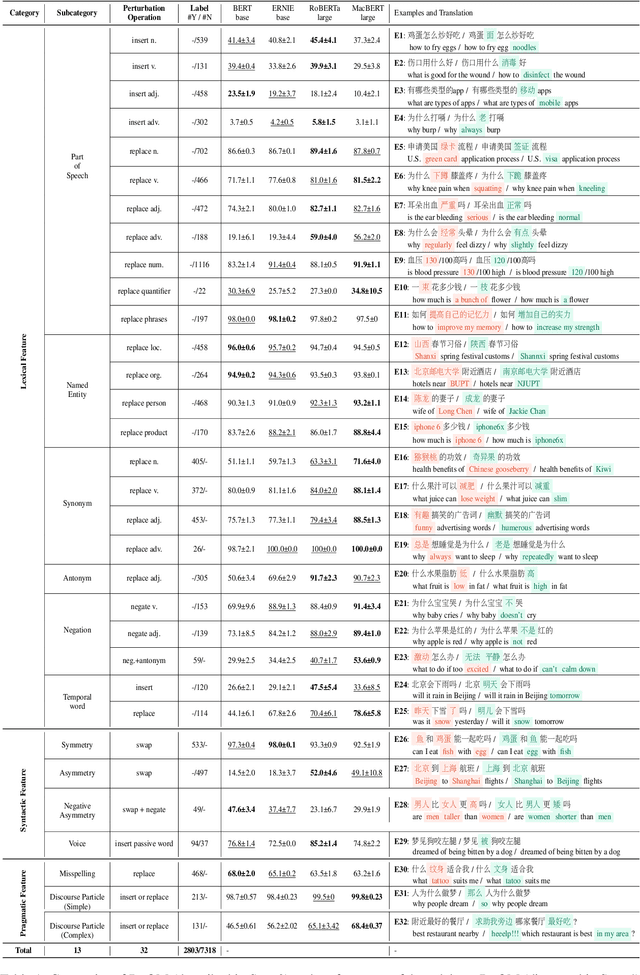
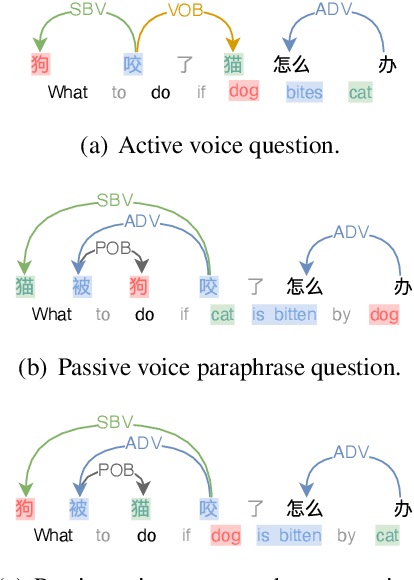
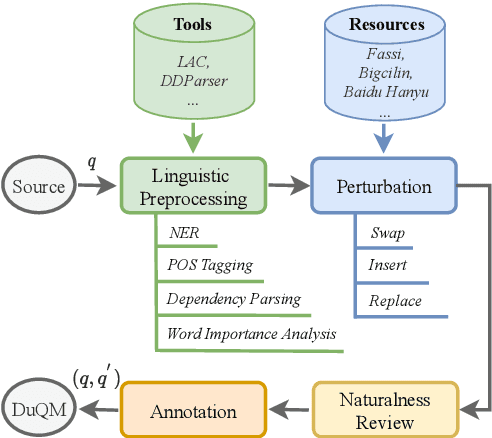
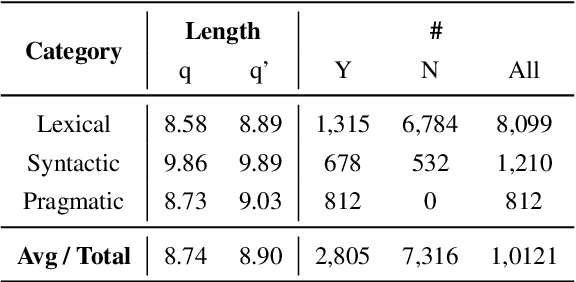
Abstract:In this paper, we focus on studying robustness evaluation of Chinese question matching. Most of the previous work on analyzing robustness issue focus on just one or a few types of artificial adversarial examples. Instead, we argue that it is necessary to formulate a comprehensive evaluation about the linguistic capabilities of models on natural texts. For this purpose, we create a Chinese dataset namely DuQM which contains natural questions with linguistic perturbations to evaluate the robustness of question matching models. DuQM contains 3 categories and 13 subcategories with 32 linguistic perturbations. The extensive experiments demonstrate that DuQM has a better ability to distinguish different models. Importantly, the detailed breakdown of evaluation by linguistic phenomenon in DuQM helps us easily diagnose the strength and weakness of different models. Additionally, our experiment results show that the effect of artificial adversarial examples does not work on the natural texts.
An Ontology-Based Artificial Intelligence Model for Medicine Side-Effect Prediction: Taking Traditional Chinese Medicine as An Example
Sep 12, 2018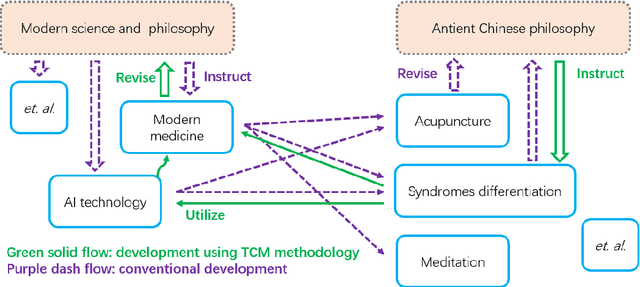
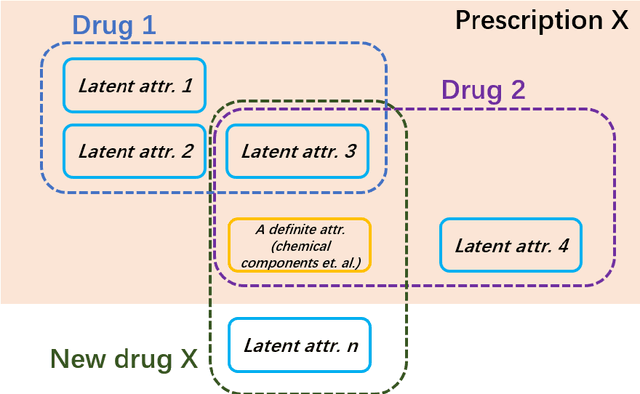
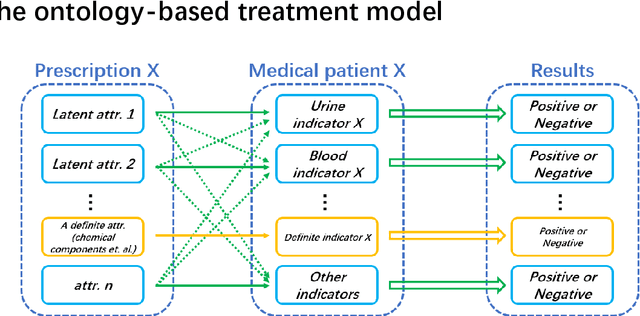
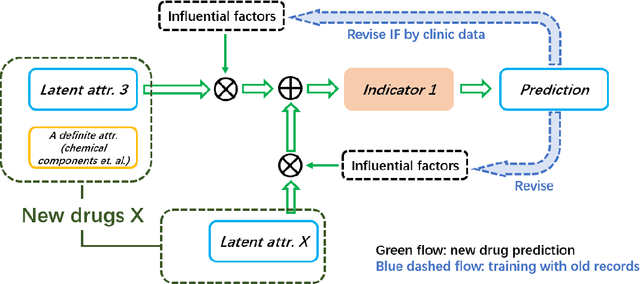
Abstract:In this work, an ontology-based model for AI-assisted medicine side-effect (SE) prediction is developed, where three main components, including the drug model, the treatment model, and the AI-assisted prediction model, of proposed model are presented. To validate the proposed model, an ANN structure is established and trained by two hundred and forty-two TCM prescriptions that are gathered and classified from the most famous ancient TCM book and more than one thousand SE reports, in which two ontology-based attributions, hot and cold, are simply introduced to evaluate whether the prediction will cause a SE or not. The results preliminarily reveal that it is a relationship between the ontology-based attributions and the corresponding indicator that can be learnt by AI for predicting the SE, which suggests the proposed model has a potential in AI-assisted SE prediction. However, it should be noted that, the proposed model highly depends on the sufficient clinic data, and hereby, much deeper exploration is important for enhancing the accuracy of the prediction.
Cost-aware Cascading Bandits
May 22, 2018

Abstract:In this paper, we propose a cost-aware cascading bandits model, a new variant of multi-armed ban- dits with cascading feedback, by considering the random cost of pulling arms. In each step, the learning agent chooses an ordered list of items and examines them sequentially, until certain stopping condition is satisfied. Our objective is then to max- imize the expected net reward in each step, i.e., the reward obtained in each step minus the total cost in- curred in examining the items, by deciding the or- dered list of items, as well as when to stop examina- tion. We study both the offline and online settings, depending on whether the state and cost statistics of the items are known beforehand. For the of- fline setting, we show that the Unit Cost Ranking with Threshold 1 (UCR-T1) policy is optimal. For the online setting, we propose a Cost-aware Cas- cading Upper Confidence Bound (CC-UCB) algo- rithm, and show that the cumulative regret scales in O(log T ). We also provide a lower bound for all {\alpha}-consistent policies, which scales in {\Omega}(log T ) and matches our upper bound. The performance of the CC-UCB algorithm is evaluated with both synthetic and real-world data.
 Add to Chrome
Add to Chrome Add to Firefox
Add to Firefox Add to Edge
Add to Edge